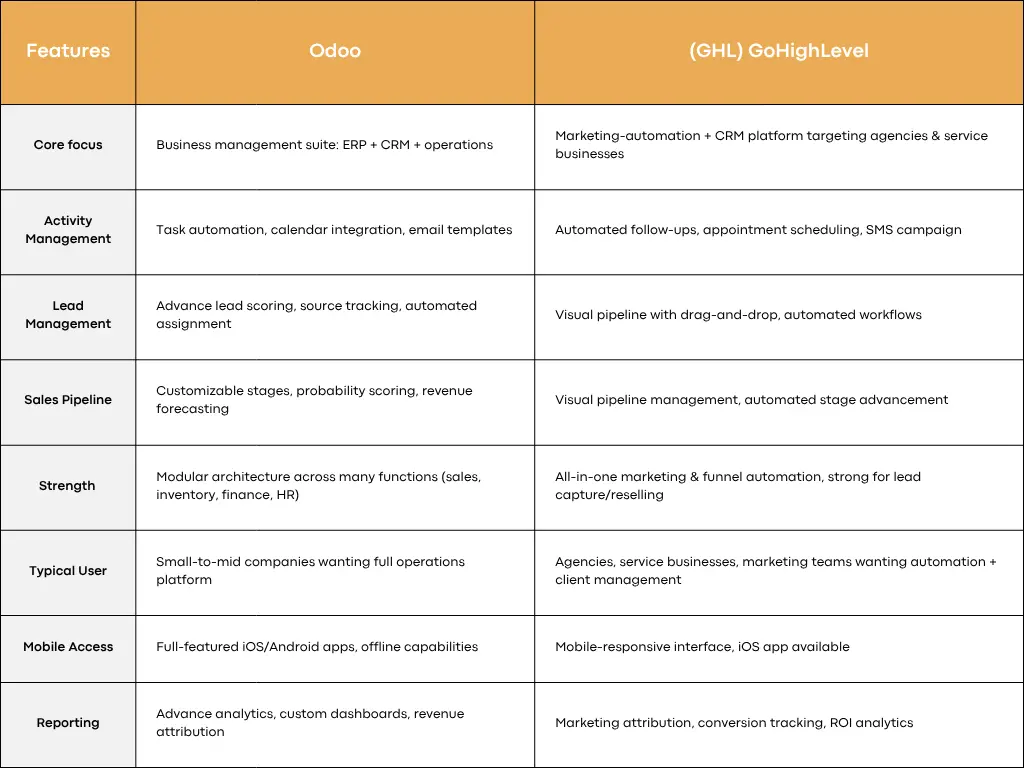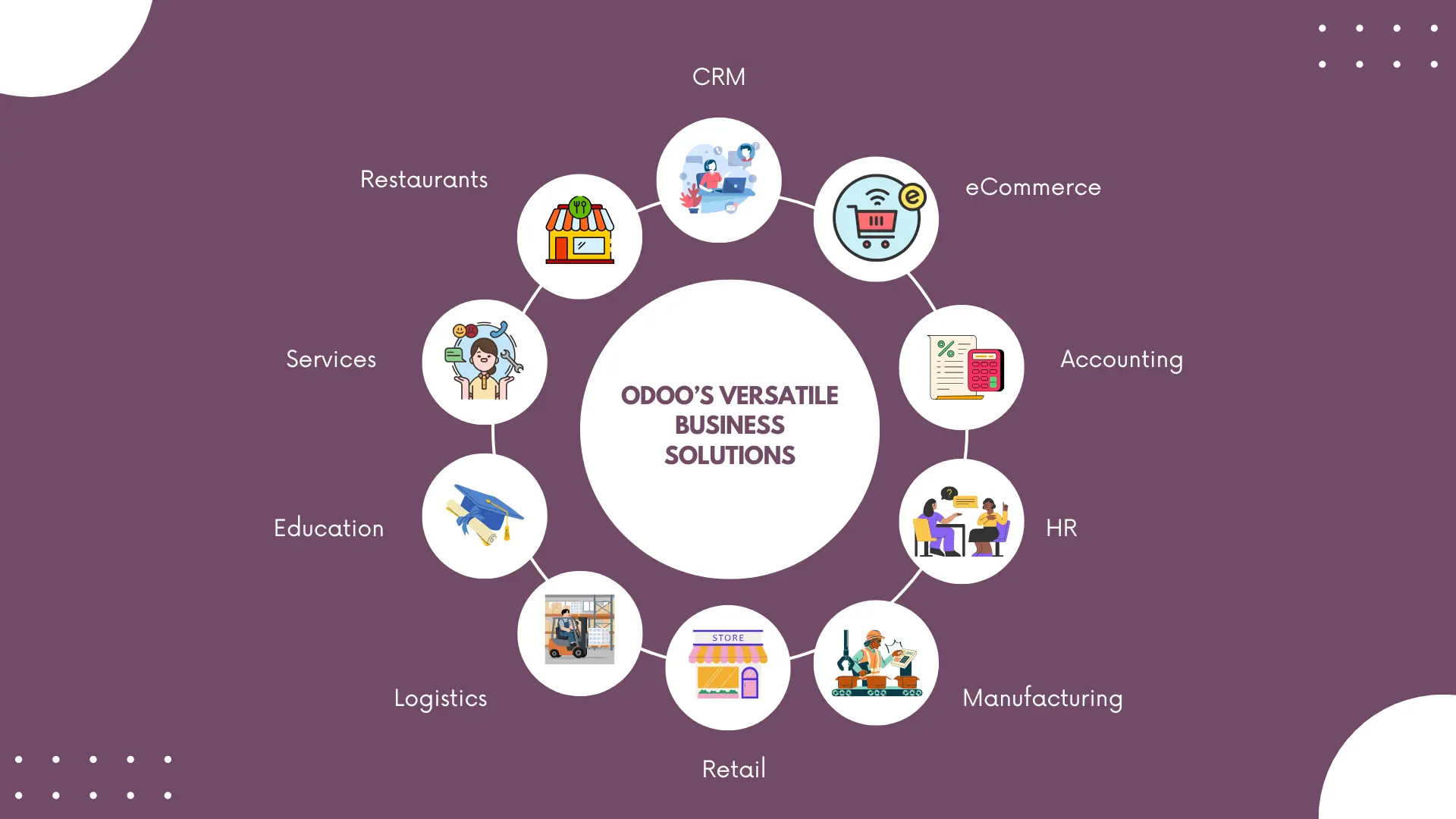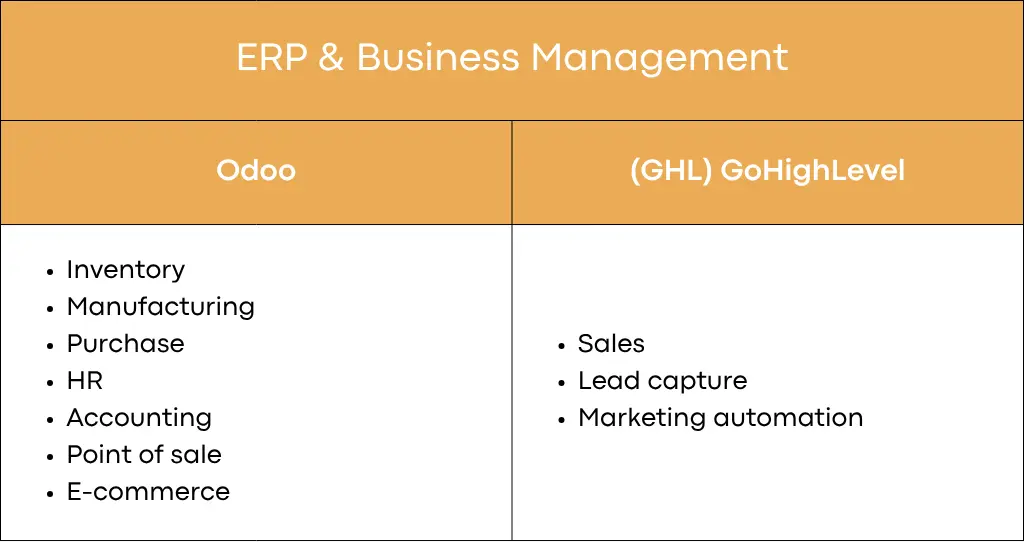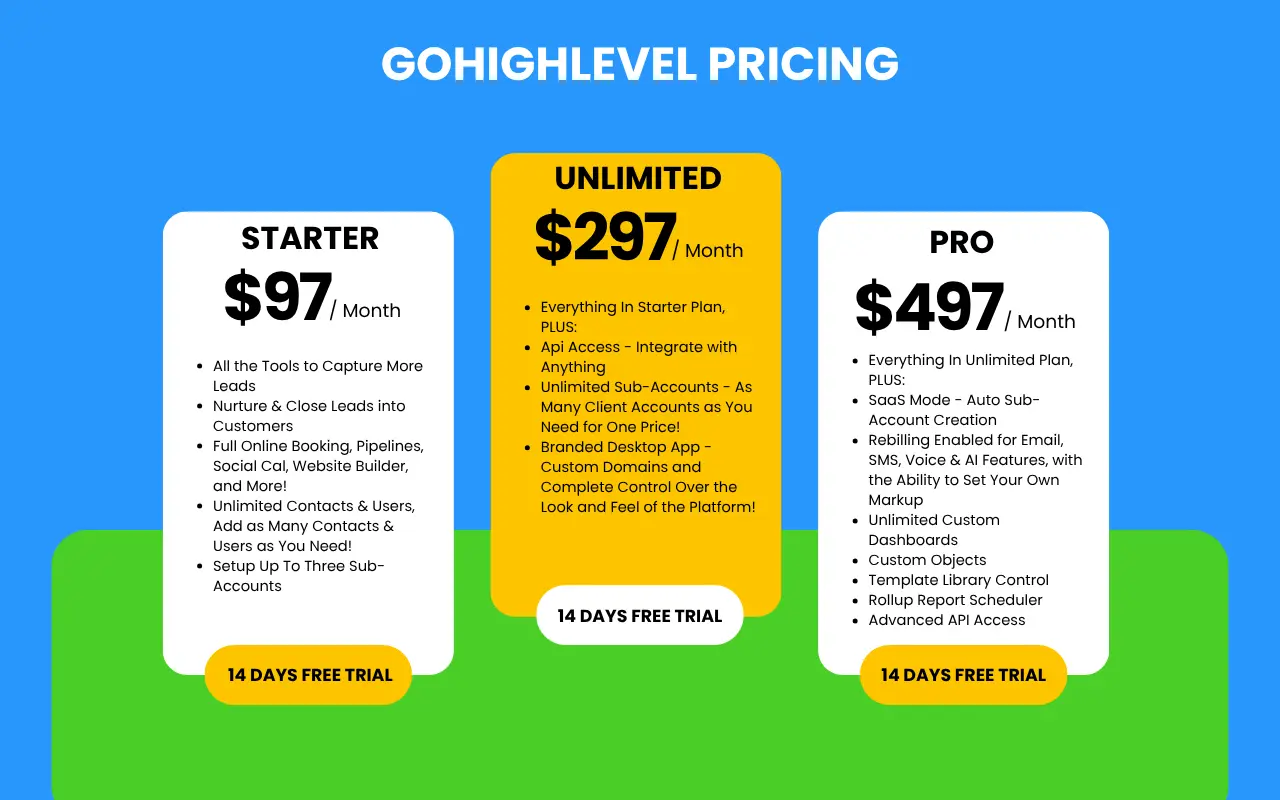Odoo vs GHL is a common debate for businesses looking for the best platform in 2026. Both platforms offer powerful tools for CRM, marketing automation, and business management, but they cater to different needs. Understanding the features, pricing, and performance of Odoo and GHL can help you choose the right solution to grow your business efficiently.
Book Your Free Audit Appointment
Discover how to optimize your operations, reduce costs, and increase profitability with Odoo.
Table of Contents
- Comparison between Odoo and GHL (GoHighLevel)
- What is Odoo
- What is (GHL) GoHighLevel
- Feature Comparison
- Integration with Other Tools
- User Experience and Interface
- Cost Comparison
- User Experience and Learning Curve
- Integration Capabilities
- Performance and Scalability
- Security and Compliance
- Customer Support and Training Resources
- Frequently Asked Questions
- Conclusion
Comparison between Odoo and GHL (GoHighLevel)
Here we give you a table comparison to ease your decision.

What is Odoo
Odoo is a modular business software suite developed by Odoo S.A. of Belgium. It is an all-in-one enterprise resource planning (ERP) platform that covers CRM, e-commerce, accounting, inventory, manufacturing, project management, and many other business functions.The modular architecture means you can enable only the apps you need and scale up. Because of this breadth, Odoo is often chosen when a company seeks to integrate across multiple business processes rather than only marketing or CRM.

The platform’s core strength lies in its seamless integration between departments and business functions. When a sales order is created in the odoo CRM, it automatically triggers inventory movements, generates accounting entries, and can initiate manufacturing processes if needed. This level of integration eliminates data silos and reduces manual work that typically plagues businesses using multiple disconnected systems.
What is (GHL) GoHighLevel
GoHighLevel (GHL) is a platform built primarily for marketing agencies, service providers and smaller business teams who want to manage leads, funnels, automations and client workflows in one place. It includes CRM, funnels/website builder, email/SMS, appointment scheduling and white-label/SaaS mode for agencies.In effect, if your primary need is capturing, nurturing and converting leads plus client-account management, GHL has a strong focus.
The GoHighLevel CRM serves as the central hub for managing leads and customer data across multiple channels. Its visual pipeline management system allows users to track prospects through customized sales stages while automated workflows handle routine follow-up tasks. The platform excels at capturing leads from various sources—landing pages, social media marketing, webforms—and immediately placing them into nurturing sequences.
Feature Comparison
Here we give you some features comparison to ease you on choosing the best option for your business, such as CRM, marketing automation, sales funnel management, and ERP & business management.
CRM
Both Odoo and GoHighLevel offer a capable CRM system, here are the differences between them.

Marketing Automation
There are some differences between its marketing automation.

Sales Funnel Management
Here are the differences between sales funnel management between Odoo vs GHL.

ERP & Business Management
Odoo is clearly an ERP system, whereas GHL is not an ERP System. In case you need a consultation about this ERP system and business management, you may contact Doodex by clicking this link.

Integration with Other Tools
Because of its modular architecture, Odoo supports many integrations, modules and third-party apps.There is even a module to sync Odoo with GoHighLevel. That means if you already use or plan to use marketing automation + ERP, you can connect them.
On the other hand, GHL provides integrations with payment gateways, calendars, funnels, and some API access (especially in higher tiers).However, compared to full ERP toolsets, it is less deep in operational integrations out of the box.
User Experience and Interface
Many users praise Odoo user-friendly interface and modern design, alongside good flexibility. In one review, Odoo CRM scored 8.3 on “ease of use”. That said, because Odoo covers many domains, some implementation may require training and configuration.
GHL designed with marketing/users in mind who want to launch quickly. Many users find it intuitive for funnels and client-centric use. The trade-off may be that if you use it for full operations you will hit limitations. Implementation tends to be faster for the marketing/agency use-case.
Cost Comparison
Odoo’s modular pricing starts free but may reach $1,500+ monthly for comprehensive implementations. Odoo offers a “One App Free” plan (unlimited users but only one app) and paid plans based on users and modules.
Typical starting pay-per-user: around US$31.10 per user per month (billed annually) for the Standard plan covering all apps. Some sources indicate ~$24.90-$30 per user/month depending on region and modules.Implementation and hosting costs can vary significantly (customisation, number of users, level of modules).
On the other hand, GoHighLevel provides tiered flat pricing, not per-user. As of 2025:
- Starter Plan: US$97/month.
- Unlimited Plan: US$297/month – unlimited sub-accounts, API access, branding.
- SaaS/Agency Pro Plan: US$497/month – white-label mode, advanced features. Discounts for annual billing (approx 16.6%) available.

User Experience and Learning Curve
User adoption significantly impacts platform success, making user experience and training requirements critical evaluation factors. The steep learning curve associated with comprehensive platforms can offset their functional advantages if teams struggle with adoption.
Odoo’s user experience characteristics:
- Professional interface designed for comprehensive business management
- Steep learning curve due to extensive functionality and customization options
- Role-based access allowing users to see only relevant modules and features
- Extensive documentation including video tutorials, user guides, and certification programs
- Partner support network providing training and implementation assistance
Odoo’s interface prioritizes functionality over simplicity, which creates challenges for non-technical users but provides powerful capabilities for experienced operators. The platform’s modular design allows businesses to gradually introduce new features as teams become comfortable with existing functionality.
Implementation timeline expectations:
- Basic CRM setup: 1-2 weeks
- Multi-module implementation: 2-6 months
- Complex customization: 6-18 months
- Full user adoption: 3-12 months after go-live
GHL’s user experience focus:
- User friendly interface designed for rapid adoption by marketing teams
- Minimal training required with intuitive workflows and visual builders
- Guided onboarding including setup wizards and template libraries
- Active support community with responsive customer service and user forums
- Mobile-friendly design enabling access from various devices and locations
GHL prioritizes ease of use and rapid deployment, making it accessible to teams without technical backgrounds. The platform’s visual builders and pre-configured workflows allow users to create sophisticated automation sequences without programming knowledge.
GHL adoption timeline:
- Platform setup: 1-3 days
- Team training: 1-2 weeks
- Advanced feature adoption: 2-4 weeks
- Full optimization: 1-3 months
User satisfaction metrics consistently favor GHL for ease of use while Odoo receives higher ratings for functionality depth and customization capabilities. The choice between these platforms often comes down to whether businesses prioritize rapid adoption or comprehensive functionality.
Contact Doodex – your trusted Odoo Partner
Discover how to optimize your operations, reduce costs, and increase profitability with Odoo
Integration Capabilities
Odoo supports a wide range of modules and external integrations. For example, its Marketing Automation module connects to CRM, e-commerce, helpdesk, inventory. There is a module that integrates Odoo with GoHighLevel (sync contacts and leads/opportunities) via API.That means you can, in principle, run Odoo for core operations and still use GHL for marketing if desired.
GHL supports funnel/website builder, email & SMS, calendars, payment gateways, sub-account/agency management, API access (especially in higher plans).While it does integrate with many tools, it is somewhat more centred on marketing/CRM tools rather than heavy ERP/business operations integrations.
Performance and Scalability
Odoo is built for scalability: as you grow you can add modules, users, companies, workflows, and integrate across business units. For example, one source notes Odoo “can scale as businesses grow to accommodate increasing data and operational complexity.”That said, scaling well often depends on good implementation, clean data, and managing customisation.
GHL is scalable in the sense of client/accounts, unlimited contacts/users (in many plans), funnel growth, and white-label/reseller modes. It can scale well for agencies handling many clients. But its scalability in full operations (manufacturing, inventory, product logistics) is more limited—the focus remains on marketing/CRM growth rather than full enterprise operations.
Security and Compliance
Data security and regulatory compliance represent critical considerations for business software selection, particularly as privacy regulations become more stringent and cyber security threats increase. Both platforms approach security differently based on their target markets and deployment models.
Odoo’s enterprise security capabilities:
- Role-based access control with granular permissions for modules, records, and fields
- Two-factor authentication supporting various authentication methods
- Data encryption for data at rest and in transit
- GDPR compliance tools including data portability and deletion capabilities
- Audit trails tracking all user actions and data modifications
- Backup and recovery systems with configurable retention policies
Odoo’s on-premise deployment option provides complete control over data location and security measures, making it suitable for organizations with strict compliance requirements or sensitive data handling needs.
Compliance support includes:
- Industry-specific modules for healthcare (HIPAA), finance (SOX), and manufacturing
- Multi-country legal and accounting standards
- Advanced reporting for regulatory compliance
- Data residency controls for international operations
GHL’s cloud-first security approach:
- SOC 2 Type II compliance ensuring enterprise-grade security standards
- Encrypted data transmission protecting communication between users and servers
- Secure payment processing with PCI DSS compliance for financial transactions
- Regular security audits and vulnerability assessments
- Automatic security updates ensuring protection against emerging threats
- Data backup systems with geographic redundancy
GHL’s cloud-only model simplifies security management for users but requires trust in the vendor’s security measures and compliance practices.

Businesses with strict compliance requirements or highly sensitive data typically prefer Odoo’s flexibility and control options. Organizations prioritizing ease of use and vendor-managed security find GHL’s approach more convenient and cost-effective.
Customer Support and Training Resources
Effective support and training resources significantly impact platform success and user satisfaction. The complexity differences between these platforms create varying support needs and resource requirements.
Odoo’s comprehensive support ecosystem:
- Tiered support plans ranging from community forums to dedicated account management
- Extensive documentation including technical guides, user manuals, and API references
- Certification programs for users, partners, and developers
- Global partner network providing local implementation and support services
- Annual user conference (Odoo Experience) with training sessions and networking
- Online learning platform with structured courses and skill assessments
Odoo’s support model emphasizes education and partner relationships, reflecting the platform’s complexity and customization requirements. Businesses typically require ongoing training as they add modules and expand functionality.
Training investment expectations:
- Initial user training: 20-40 hours per user
- Administrator training: 80-120 hours
- Developer certification: 200+ hours
- Ongoing education: 10-20 hours annually per user
GHL’s accessible support approach:
- Live chat support with rapid response times during business hours
- Email ticket system for detailed technical issues
- Weekly training webinars covering platform features and best practices
- Facebook community with 40,000+ active members sharing tips and strategies
- Knowledge base with searchable articles and video tutorials
- Onboarding assistance including setup guidance and initial optimization
GHL’s support philosophy prioritizes accessibility and rapid problem resolution, recognizing that users need immediate help to maintain marketing campaigns and client communications.
Support comparison:

Organizations with technical teams or complex implementation requirements benefit from Odoo’s comprehensive educational resources and partner ecosystem. Businesses prioritizing rapid deployment and intuitive operation find GHL’s streamlined support approach more suitable for their needs.
Read more: Odoo vs. SAP: A Comprehensive Comparison of ERP Systems
Frequently Asked Questions
Can I start with one and migrate to the other later?
Yes, for example you might start with GHL for marketing/CRM, and later adopt Odoo for full operations. Or you might start with Odoo for operations and integrate marketing tools. Because modern tools support APIs and modules, migration is possible but will require planning.
How do upgrade and migration processes compare?
Odoo upgrades can be complex due to customizations and module dependencies, often requiring technical assistance for major version changes. The platform’s stability and long-term roadmap provide confidence for enterprise planning. GHL handles upgrades automatically in the cloud with minimal user impact, though the proprietary nature creates vendor lock-in concerns for large implementations.
Can Odoo and GHL integrate with each other?
Yes, these platforms can connect through API integrations or middleware like Zapier. However, this setup typically indicates misaligned platform selection since each excels in different business areas. Businesses requiring both comprehensive ERP and advanced marketing automation should evaluate whether one platform meets their primary needs while integrating simpler tools for secondary function.
Will I always need both marketing and operations systems?
Yes, many businesses do. If your marketing/CRM is separate from operations (inventory, service delivery), you’ll need coordination either via one system or via integrations.
You may need a professional to help you coordinate your system, Doodex expertise is here to assist you, contact us by clicking this link.
Which platform offers better mobile functionality?
Both platforms provide mobile access, but with different focuses. Odoo offers comprehensive mobile apps for iOS and Android with full CRM functionality, inventory management, and offline capabilities. GHL provides excellent mobile responsiveness and an iOS app optimized for communication management, pipeline updates, and campaign monitoring. Choose based on your team’s mobile work requirements.
How much does implementation cost?
For Odoo, implementation cost varies widely (depending on modules, users, customisation). One study suggests $5,000-$50,000+ depending on size. SDLC Corp For GHL, the monthly cost is clear but you may still incur onboarding/training costs.
Is one better for small business vs enterprise?
Small businesses focusing on marketing may prefer GHL. Businesses that expect growth into complex operations may prefer Odoo.
Which has better marketing automation?
GHL has very strong marketing/funnel automation built from the marketing/agency side. Odoo also includes strong marketing automation but within a broader business operations platform.
Which platform has better customer retention rates?
GHL reports higher customer satisfaction scores and lower churn rates, partly due to flat-rate pricing and rapid deployment. Odoo users show higher long-term retention after successful implementation, reflecting the platform’s deep integration into business operations. Initial adoption challenges affect Odoo’s short-term satisfaction but don’t impact long-term business value.
Conclusion
The decision between Odoo and GHL ultimately depends on your business’s fundamental operational model rather than size, industry, or budget alone. These platforms serve distinctly different purposes and excel in their respective domains.
If you are building or managing a business where marketing/CRM is the central need (especially as a service/agency), GoHighLevel offers a compelling, fast-deploying solution. If your business is broader—covering sales, operations, inventory, manufacturing, HR, finance—and you seek a unified solution, Odoo is highly attractive.
Decision framework for evaluation:
- Identify your primary value driver: Operations efficiency vs. customer acquisition
- Assess technical resources: Available expertise for implementation and maintenance
- Plan growth trajectory: Operational expansion vs. marketing scaling
- Calculate total investment: Include implementation, training, and ongoing costs
- Test user experience: Trial both platforms with realistic business scenarios
Hybrid approach considerations:
Some businesses benefit from using both platforms for different functions—Odoo for operations and GHL for marketing automation. However, this approach increases complexity and costs while potentially creating data synchronization challenges.
Action steps for your evaluation:
- Start with free trials of both platforms using real business data
- Map your current workflows to identify integration requirements
- Interview teams about their daily activities and pain points
- Calculate costs including implementation, training, and ongoing support
- Test mobile functionality with your team’s typical work patterns
The right choice aligns with your business model, growth plans, and operational complexity rather than feature quantity or general popularity. Both platforms excel when properly matched to appropriate business requirements, but neither succeeds when forced into misaligned use cases.
Your platform decision will impact business operations for years, making thorough evaluation essential. Focus on how each platform supports your specific business goals rather than comparing feature lists in isolation. The better ROI comes from choosing the platform that enhances your competitive advantages and operational strengths.
If you need professional assistance, you may contact Doodex to help you decide the best choice for your business, contact us through this link.